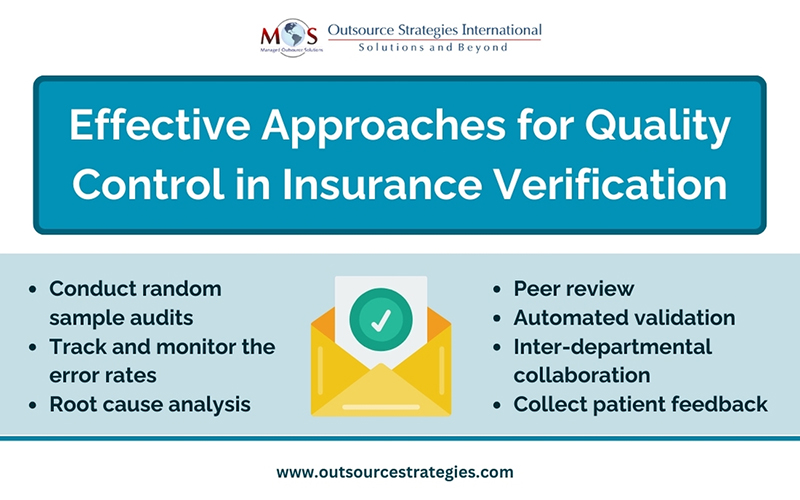Verification of patient benefits before providing the services is a proactive measure that contributes to accurate billing, reduces financial risks for both the physician and the patient, and improves the overall efficiency of the medical billing process. Maintaining high-quality health insurance verification supports accurate billing, reduces claim denials, and enhances a practice’s overall financial performance. Companies providing insurance eligibility verification services have stringent quality assurances measures in place to ensure accuracy and reliability of the process. Quality assurance helps identify and rectify errors, inconsistencies, or potential issues before they impact billing, claims processing, or patient satisfaction.


Ensure efficiency in patient eligibility verification with high quality insurance verification services
Strategies for Maintaining High-Quality Insurance Verification
Here are some important quality assurance measures for seamless patient eligibility verification:
Develop Clear Procedures
Health insurance verification involves multiple steps – from precise data collection to coverage validation by communicating with insurance companies and patients. Establish and document standardized procedures and create a checklist for the verification. This should include step-by-step guidelines on collecting and verifying patient information, insurance details, and coverage eligibility. All front desk staff should be trained on these procedures.
Double-Check Patient Information
Accurate patient information is essential for successful insurance verification. The process starts with collecting patient data such as demographics, insurance details, plan details, and payment methods. Efficient eligibility verification depends on having accurate patient data. Provide thorough training to office staff, emphasizing the importance of accurate transcription when inputting information into patient records. Even a minor error, such as entering a wrong number, can lead to claim denials.
OSI’s teams audit on the back end to ensure the benefits we provide are accurate, preventing any discrepancies that may lead to unneeded claim denials. We have relevant experience in the field. “For multispecialty practices with more than one provider on site, our teams have experience with checking coverages for services that are categorized according to the appropriate provider/NPI to ensure those services get paid appropriately”, says Natalie Tornese CPC, OSI’s Director of Revenue Cycle Management, Healthcare Division.
Perform Real-Time Eligibility Verification
Whenever possible, aim for real-time eligibility verification or instantly confirming the accuracy and validity of patient insurance information at the point of service. Confirming coverage details immediately reduces the risk of relying on outdated or inaccurate information.
Integrating with insurance databases and systems can facilitate real-time verification. This instant confirmation helps avoid delivering services to ineligible/uninsured patients. With real-time information on a patient’s insurance coverage, you can accurately estimate the patient’s financial responsibility, including co-payments, deductibles, and coinsurance, and inform them about the potential costs upfront.
Verify Insurance Coverage Levels
Ensure that the insurance coverage levels are thoroughly verified. This includes checking the following:
- Whether coverage is currently active
- Which services and treatments are covered under the policy
- Whether the insurance covers the procedure, diagnosis, or services to be provided
- Whether the patient has secondary insurance and its coverage details
- Limitations of the policy (such as visit limits), including exclusions or documentation requirements for claims
- Benefit caps: if there are any annual or lifetime maximum coverage amounts for specific services
- The amount of the patient’s copay and deductible
- If there are any annual or lifetime maximum coverage amounts for specific services.
This list helps in accurately estimating patient responsibility and prevents surprises during the billing process.
Document and Track Changes
Keep a detailed record of insurance verification activities and ensure this is easily available to billing staff for future reference. Document any changes in patient information or insurance coverage. Having a comprehensive history allows you to track trends, identify potential issues, and improve the overall accuracy of the verification process.
Regular Staff Training
Insurance policies and procedures change frequently. In a practice that is fully trained on reliable insurance verification, staff stay up-to-date on the latest industry changes, coding updates, and insurance regulations. This ongoing education ensures that they are equipped to handle any changes in the entire insurance verification process.
Collaboration with Payers
Establishing open communication channels with insurance companies is an important for maintaining high quality insurance verification. Practices should understand their carrier contracts and billing processes, such what services you can bill and get paid for same day for same/different providers in the office, says OSI’s CPC expert.
OSI’s insurance verification specialists have strong relationships with payers and call them directly to clarify any uncertainties and ensure the accuracy of information. This facilitates smoother verification processes and resolution of any issues that may arise.
Stay Compliant with Regulations
Staying informed about and adhering to the latest healthcare and insurance regulations is fully necessary. Compliance with legal requirements contributes to maintaining high-quality insurance verification processes and protects your practice from penalties.
Implement Quality Control Checks
Quality control measures for insurance verification services can be done by introducing internal audits or third-party assessments to review a sample of insurance verifications. This can help identify and address errors or inconsistencies promptly and maintain high standards.
Here are some approaches for quality control in insurance verification:
- Conduct random sample audits: Select and review a percentage of cases each week or month. This thorough review ensures that the verification process is consistently accurate and prevents systemic errors.
- Track and monitor the error rates: Establish acceptable error rate thresholds, and regularly analyze data to identify any trends or patterns. High error rates may indicate areas that need attention.
- Root cause analysis: Analyze the root causes of any errors or discrepancies identified during insurance verification. This will allow you to take action to prevent recurring errors.
- Peer review: This is a collaborative approach where experienced team members review the work of their colleagues. It promotes accountability and knowledge-sharing, allowing staff to learn from each other’s experiences.
- Automated validation: Incorporate automated validation tools within an insurance verification system. The technology can validate key data points, such as patient information and insurance coverage details, and flag any discrepancies or potential errors for manual review.
- Inter-departmental collaboration: Insurance verification service providers should collaborate with billing and coding departments to cross-check information. This will reduce the likelihood of errors that could lead to claim denials.
- Collect patient feedback: Analyzing customer feedback helps identify any issues from the user’s perspective and provide insights for process enhancement.

Interested in learning more?
Explore our in-depth dive into compliance and quality assurance in insurance verification: Compliance and Quality Assurance in Insurance Verification
Quality assurance for the health insurance eligibility verification process requires consistently reviewing and updating relevant policies and procedures. Documentation should be updated when there are changes in insurance regulations, payer policies, or internal processes. This will ensure that your practice maintains high-quality health insurance verification that supports accurate billing, increase revenue, and enhances patient satisfaction.


Ensure seamless insurance verification, reduce claim denials, and streamline your workflow.





